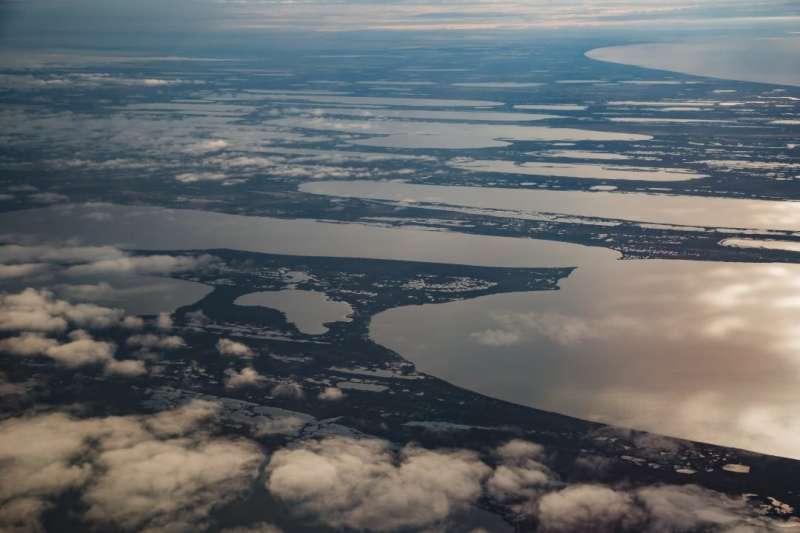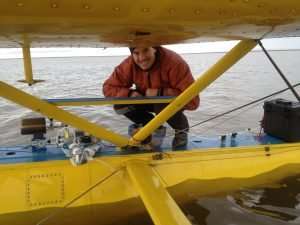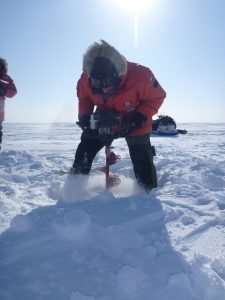Arctic lakes are releasing relatively young carbon, study discovers

When Arctic permafrost soil thaws, greenhouse gases are released into the atmosphere, but most of the carbon currently escaping from lakes in northern Alaska is relatively young, according to a new study led by researchers at the University of California, Irvine.
"This finding is crucial, because much of the biomass stored underground in the Arctic is ancient, dating back to the Pleistocene Epoch, which ended more than 11,500 years ago," said Claudia Czimczik, UCI associate professor of Earth system science, who led the study appearing this week in Nature Climate Change. "When the bulk of that very old carbon is recycled and released, we will be looking at a massive net increase in emissions of the gases that worsen global warming."
But researchers using carbon-14 dating techniques have determined that the carbon being emitted by these Arctic lakes accumulated in recent decades and centuries, versus several millennia, which means that there will be less of an impact on the climate.
"These young carbon pools most likely include comparatively fresh photosynthetic products flushed into the lakes from their surrounding watersheds, organic material from aquatic plants and phytoplankton, or waterborne dissolved inorganic carbon," said lead author Clayton Elder, a research scientist at NASA's Jet Propulsion Laboratory who was Ph.D. student at UCI during this project.

The research team investigated a diverse selection of lakes across a 96,500-square-mile section of Alaska's North Slope, an area larger than Oregon. They took samples in both winter and summer months in 2013 and 2014.
By studying lakes over a large region, the scientists were able to illustrate the impact of the physical environment on carbon emission patterns. Differences in sediment textures in the permafrost surrounding the lakes play a role; finer particles can sequester more carbon for longer periods than can sandier soils. Thawing of finer sediments may also release greater quantities of nutrients to stimulate microbial decomposition of organic material, expelling more greenhouse gases.
Another key finding is that almost all of the greenhouse gases being emitted from the studied bodies of water was in the form of carbon dioxide (CO2), not methane (CH4). CO2 is about 30 times less effective in trapping solar heat than is CH4. Elder said that what little ancient carbon is being emitted from Alaskan lakes is also mostly CO2 instead of CH4.

"This implies that a large proportion of the CH4 produced in lake sediments is oxidized to CO2 in the water column before emission into the atmosphere," he said. "Ice cover, which is sensitive to climate, is particularly important for converting would-be CH4 emissions into the less impactful CO2, because it impedes emissions and makes CH4 vulnerable for longer periods to oxidizing microbes living in the water column. If we lose more and more ice in the future because of warming, higher proportions of carbon could be emitted as CH4."
Other research has demonstrated that while methane from ancient carbon reservoirs is released into bottom waters of the Arctic Ocean off the Alaskan coast, only small quantities actually make it to the surface. This suggests that water-column oxidation is a strong control on the emission of ancient carbon into the atmosphere as the powerful greenhouse gas CH4.
Elder called this survey a first for Arctic lakes. "Our goal was to measure greenhouse gas emissions on relevant scales of space and time, so our data set represents an important baseline that future studies can use for comparison purposes," he said. "These sensitive environments have been grossly understudied in the past, especially given their potential impact on global climate."
More information: Clayton D. Elder et al. Greenhouse gas emissions from diverse Arctic Alaskan lakes are dominated by young carbon, Nature Climate Change (2018). DOI: 10.1038/s41558-017-0066-9
Journal information: Nature Climate Change
Provided by University of California, Irvine



















